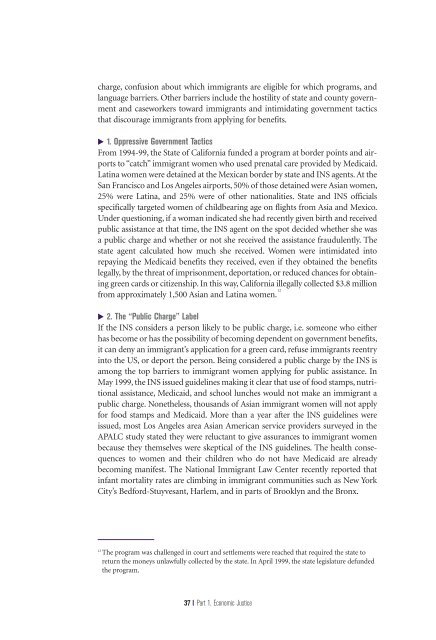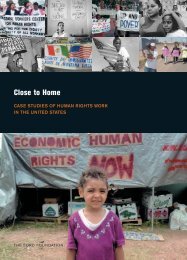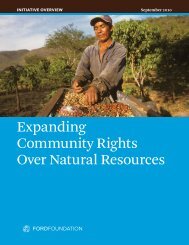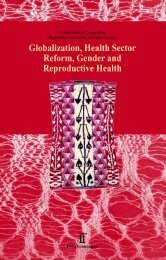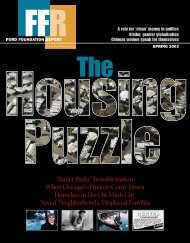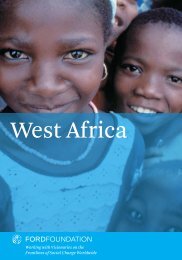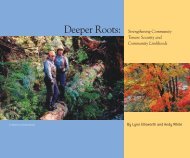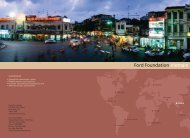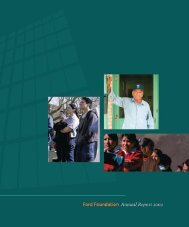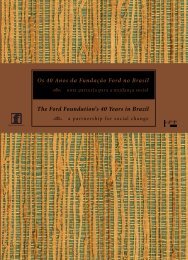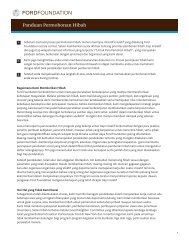Asian American Women - Ford Foundation
Asian American Women - Ford Foundation
Asian American Women - Ford Foundation
Create successful ePaper yourself
Turn your PDF publications into a flip-book with our unique Google optimized e-Paper software.
charge, confusion about which immigrants are eligible for which programs, and<br />
language barriers. Other barriers include the hostility of state and county government<br />
and caseworkers toward immigrants and intimidating government tactics<br />
that discourage immigrants from applying for benefits.<br />
1. Oppressive Government Tactics<br />
From 1994-99, the State of California funded a program at border points and airports<br />
to “catch” immigrant women who used prenatal care provided by Medicaid.<br />
Latina women were detained at the Mexican border by state and INS agents. At the<br />
San Francisco and Los Angeles airports, 50% of those detained were <strong>Asian</strong> women,<br />
25% were Latina, and 25% were of other nationalities. State and INS officials<br />
specifically targeted women of childbearing age on flights from Asia and Mexico.<br />
Under questioning, if a woman indicated she had recently given birth and received<br />
public assistance at that time, the INS agent on the spot decided whether she was<br />
a public charge and whether or not she received the assistance fraudulently. The<br />
state agent calculated how much she received. <strong>Women</strong> were intimidated into<br />
repaying the Medicaid benefits they received, even if they obtained the benefits<br />
legally, by the threat of imprisonment, deportation, or reduced chances for obtaining<br />
green cards or citizenship. In this way, California illegally collected $3.8 million<br />
from approximately 1,500 <strong>Asian</strong> and Latina women. 12<br />
2. The “Public Charge” Label<br />
If the INS considers a person likely to be public charge, i.e. someone who either<br />
has become or has the possibility of becoming dependent on government benefits,<br />
it can deny an immigrant’s application for a green card, refuse immigrants reentry<br />
into the US, or deport the person. Being considered a public charge by the INS is<br />
among the top barriers to immigrant women applying for public assistance. In<br />
May 1999, the INS issued guidelines making it clear that use of food stamps, nutritional<br />
assistance, Medicaid, and school lunches would not make an immigrant a<br />
public charge. Nonetheless, thousands of <strong>Asian</strong> immigrant women will not apply<br />
for food stamps and Medicaid. More than a year after the INS guidelines were<br />
issued, most Los Angeles area <strong>Asian</strong> <strong>American</strong> service providers surveyed in the<br />
APALC study stated they were reluctant to give assurances to immigrant women<br />
because they themselves were skeptical of the INS guidelines. The health consequences<br />
to women and their children who do not have Medicaid are already<br />
becoming manifest. The National Immigrant Law Center recently reported that<br />
infant mortality rates are climbing in immigrant communities such as New York<br />
City’s Bedford-Stuyvesant, Harlem, and in parts of Brooklyn and the Bronx.<br />
12<br />
The program was challenged in court and settlements were reached that required the state to<br />
return the moneys unlawfully collected by the state. In April 1999, the state legislature defunded<br />
the program.<br />
37 Part 1, Economic Justice


